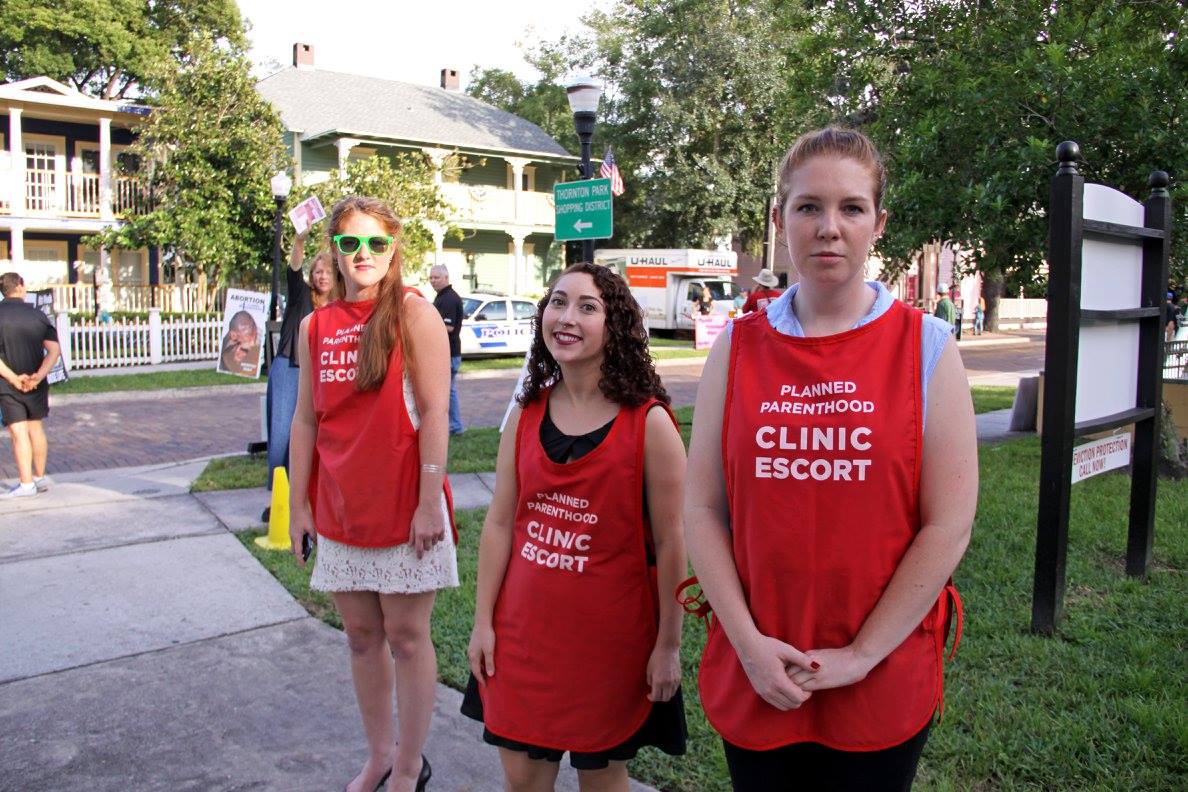After writing “ Storytelling and Patient Advocacy,” I cuddled up to a cup of warm coffee and reflected on the various moments in my life that inspired me or motivated me to take action. I thought about my story; why I applied to medical school and why I have certain research interests. Then I asked why I want to improve access to and the quality of reproductive health care. Immediately I thought about the question friends and family frequently ask me: “Why would you support Planned Parenthood if you want to help women?” My answer is this story:
As a third year medical student who will soon be applying to an obstetrics and gynecology residency, I am afraid. The recent violence in my community and continued aggression against Planned Parenthood suggests that aligning oneself with the organization is risky. Becoming an obstetrician gynecologist (OB/GYN) has been my dream since elementary school, so I feel anxious when family members share concerns that publicly supporting Planned Parenthood ensures I will not match to an OB/GYN program. Will standing with Planned Parenthood keep me out of a program? Is it OK to discuss abortion training on a residency interview? Or do I need to use code like, “What family planning training opportunities are available?” And in light of the attack on the clinic in Colorado, is my life in danger? A pro-reproductive rights provider and avid supporter of Planned Parenthood wrote to me, stating that she is afraid to rotate at their clinics for fear of an attack. She hauntingly added, “The terrorism is working.” I almost never employ self-censorship, yet I too hesitated to continue to develop a professional relationship with Planned Parenthood. Even scarier is to discuss that affiliation publicly. A friend reminded me that in times of confusion or fear, it is best to have a mantra that can elicit courage. My inner voice reminds me, “Be a rock star woman.”
A couple years ago, after my reproductive and endocrinology module, and after being influenced by readings about sexually transmitted disease (STD) pathology, I requested a full STD screen during my annual well-woman exam. The nurse told me, “We don’t do that here. You’ll have to go somewhere like Planned Parenthood.” I left embarrassed and did not follow-up with another clinic. Enter my third year clerkships when, on a pediatric service, my team treated a 15 year old female who was 21 weeks pregnant presenting with “vaginal pain and fainting during sex.” I was ecstatic to finally manage an obstetrics (OB) case, and I excitedly took a medical history. While writing my notes, I overheard a group of nurses say that this girl would not have “gotten herself pregnant” if she knew how to use a condom. I interjected that the American College of Obstetrics and Gynecology now recommends long-acting intrauterine devices (IUDs) as the leading contraceptive option for adolescents because it is the most effective, safe, private, and does not rely on user consistency (ACOG, 2012). Three nurses and a resident mistakenly retorted that IUDs cannot be given to adolescents or females who have not been pregnant due to increased risks to the uterus. Because an intrauterine device is placed inside of the uterus during an office pelvic exam and contains a small string that trails into the vagina, old theories warned about uterine perforation, pelvic inflammatory disease (PID), and subsequent infertility. They are wrong. There are no cases of infertility following IUD use, no increased absolute risks for PID, and minimal incidence of uterine perforation (ACOG, 2012; ARHP, 2015). Shockingly, this has been known in the medical community for more than a decade, yet there continues to be widespread ignorance about it among healthcare professionals.
I observed a similar case during a later clinical experience. I listened to the physician refuse an IUD to a young woman with a history of unintended pregnancies based on his belief that adolescents are promiscuous and will develop pelvic infections. His words, “We don’t offer those here. You’ll have to go somewhere else like Planned Parenthood.” Do you see the pattern? It is no secret that judgement, ignorance, and prejudice exist in healthcare. What is a medical student to do when faced with blatant disregard for clinical guidelines and scientific evidence that has been undisputed by science for over a decade? I decided to contribute to the advancement of research and education by volunteering with Planned Parenthood, an organization that provides safe, up-to-date, and judgement-free care.
I regularly volunteer at Planned Parenthood as a patient escort, walking patients from their vehicles to the clinic doors. Let me set the scene. My local office is visited by anywhere from three to more than twenty protestors daily. They stand on the sidewalk mostly shouting and waving signs at passing cars. A few people silently pray with a rosary. The first time I arrived, I had to excuse myself to the restroom because the hateful screams of “Baby killer with blood all over your hands!” were too shocking for me to bear. Eventually I became better equipped to disregard protestors. However, that took time, and if I, a student medical provider, was mortified when my gynecologist’s office told me to go to Planned Parenthood for a standard STD screen, can you imagine the emotions a young patient experiences when walking from their car at a Planned Parenthood clinic, listening to protestors scream? So I stand for hours in front of a Planned Parenthood clinic, deflecting the endless onslaught of insulting remarks, in the hopes that people can feel a little more secure receiving an STD screen, a pap smear, an IUD placement, or yes, an abortion.
The fact remains that Planned Parenthood is a leading provider of reproductive health care services. A central focus is prevention, encompassing STD and cancer screening as well as contraception. They provide prenatal services and references for those choosing to pursue adoption, in addition to abortion services and other reproductive health care. The Guttmacher Institute, another source of global sexual and reproductive health, reported in July 2015 that half of all pregnancies each year (greater than 3 million) are unintended; the same statistic that has existed for two decades (Guttmacher, 2015). More than half of women of reproductive age (13-44 years old; 38 million) need contraceptive services, and 20 million of those women require publicly funded services and supplies. In addition, the average Planned Parenthood health center serves significantly more women seeking contraceptive services than all other publicly-funded safety-net clinics.
An interview on Fresh Air with Jonathan Eig, author of The Birth of the Pill: How Four Crusaders Reinvented Sex and Launched a Revolution, made me think more about Planned Parenthood’s role in women’s health care. In the book he describes the challenges scientists and Margaret Sanger faced when trying to develop a “magic pill that would allow women to control when and if they got pregnant”—Wouldn’t that be great? Oh wait, we thankfully have that now in pill, patch, injection, implant, and intrauterine device forms. The developers of the pill studied progesterone’s effect on inhibiting ovulation under the guise that they were studying infertility treatment. I wonder if the current, hostile climate surrounding Planned Parenthood will later be compared to the ludicrousness of 1950s-era United States, when our country outlawed female contraception, while allowing men to easily purchase condoms. When I learn about the backlash surrounding the development of birth control, arguably the most important invention of the 20th century, how could I let threats prevent me from supporting an organization that is one of the few to consistently provide safe and evidence-based services without judgement? The answer is, I cannot. My career goal is to help women access and achieve the best reproductive care. That is why I stand with Planned Parenthood.
References:
American College of Obstetrics & Gynecology. (2012). ACOG committee opinion no. 539: Adolescents and Long-Acting Reversible Contraception: Implants and Intrauterine Devices. Obstet Gynecol. 117(6):1472-83.
Association of Reproductive Health Professionals (2015). The Facts About Intrauterine Contraception [Fact Sheet]. Retrieved from http://www.arhp.org/Publications-and-Resources/Clinical-Fact-Sheets/The-Facts-About-Intrauterine-Contraception-
Guttmacher Institute. (2015). Publicly Funded Family Planning Services in the United States [Fact Sheet]. Retrieved from http://www.guttmacher.org/pubs/fb_contraceptive_serv.html
Featured image:
Me (far left) escorting guests to the annual Planned Parenthood of Southwest and Central Florida Fundraising Gala.


